#fossil sponge
Explore tagged Tumblr posts
Photo

EXCEPTIONALLY RARE: Siphonia tulipa Fossil Sponge | Upper Albian Cretaceous Haldon Hills Devon UK | Genuine Specimen with COA
Discover an exceptionally rare and scientifically significant fossil—this beautifully preserved specimen of Siphonia tulipa, an extinct Cretaceous sponge from the Upper Albian stage of the Cretaceous period, collected from the Upper Greensand Formation of the Haldon Hills, Devon, UK. Sponges of this calibre and preservation are seldom found and highly sought after by collectors and researchers alike.
Fossil Type: Sponge (Porifera)
Species: Siphonia tulipa
Geological Period: Cretaceous (~113 to 100.5 million years ago)
Geological Stage: Upper Albian
Formation: Upper Greensand
Location: Haldon Hills, Devon, United Kingdom
Scale Rule: Squares/Cube = 1cm (Please refer to the photo for accurate sizing)
Specimen: The specimen shown in the photo is the exact one you will receive
Authenticity: All of our fossils are 100% genuine specimens and come with a Certificate of Authenticity
Geological and Paleontological Information
Siphonia tulipa is a genus of extinct siliceous sponge characterised by its elegant vase- or tulip-shaped body, often with a central osculum (opening) and stalked base for attachment to the seafloor. These sponges lived in shallow marine environments during the Upper Albian of the Cretaceous period, a time marked by significant marine diversification.
Phylum: Porifera
Class: Demospongiae
Order: Hadromerida
Family: Siphoniidae
Genus: Siphonia
Species: Siphonia tulipa
Geological Stage: Upper Albian (~105 million years ago)
Depositional Environment: Shallow, warm marine shelf with calcareous and glauconitic sandy sediments typical of the Upper Greensand; ideal for sponge colonization and fossilization
Morphological Features: Distinctive tulip or flask-shaped body with a central osculum; typically hollow with preserved internal canal structures; fine surface texture may show radial ridging or tubercles
Notable: Fossils of Siphonia tulipa from Haldon Hills are extremely rare and prized for their completeness and clarity of preservation
Biozone: Correlates with Upper Albian ammonite zones (e.g., Mortoniceras inflatum Zone), aiding regional stratigraphic dating
Identifier: First formally described in 19th-century British paleontological literature during the survey of the Upper Greensand faunas
Why This Fossil Is Special
This is not your average fossil sponge—Siphonia tulipa is exceptionally rare, especially in such a well-preserved state from the classic Upper Greensand of Devon. Its beautiful form, striking preservation, and scientific relevance make it a centrepiece for any fossil collection or educational exhibit.
Why Buy From Us?
100% genuine fossil with Certificate of Authenticity
Exact specimen shown is what you’ll receive
Carefully sourced from historic UK fossil sites
Ideal for collectors, researchers, and museums
Secure this remarkable example of ancient marine life—an exceptionally rare Siphonia tulipa fossil sponge from the Upper Albian Cretaceous of Haldon Hills, Devon, preserved for over 100 million years beneath England’s prehistoric seas.
#Siphonia tulipa#fossil sponge#rare fossil sponge#Upper Greensand fossil#Cretaceous sponge#Albian fossil#Haldon Hills fossil#Devon fossil#UK fossil#Siphoniidae fossil#Cretaceous invertebrate#fossil with certificate#genuine fossil#certified sponge fossil#natural history fossil#paleontology specimen#fossil collection#ancient marine life
0 notes
Note
> Cymbastela cantharella
Okay but what is that thing? I thought it was a mushroom, but everything I found showed it as an animal? Is it like a coral or a sea sponge or what?
Cymbastela cantharella is a species of sea sponge, which are considered animals! just like us, they have tissues, eat other organisms, and sexually reproduce using sperm cells!
sponges are also believed to have been the first animal, with fossils indicating sponges may have existed over 760,000,000 years ago!
say hi to grandpa!

384 notes
·
View notes
Text
Perspectives #7

"Garden of Cambrian Sights”
Innovatiocaris/Microdictyion/Haikouichthys/Eldonia/Fortiforceps
Cambrian, 518 million years ago, Maotianshan Shales (China) The Chengjiang Biota was composed of a hugely diverse array of invertebrates. Just in this picture alone, you have Innovatiocaris, Microdictyon, Fortiforceps, Eldonia, Haikouichthys, primitive annellids, priapulida, sponges, and echinoderms. It might not have always looked as helish as this, though... Based on the third panel of "The Garden of Earthly Delights" by Hieronymous Bosch.
This is a part of my Perspectives series! You can find previous entries in #perspectives on my blog.
#yee art#paleoart#paleoblr#palaeoblr#cambrian#fossil#nature art#ocean#innovatiocaris#lobopod#anomalocaris#cambrian explosion#worms#eldonia#haikouichthys#fortiforceps#sponge#shrimp#perspectives
93 notes
·
View notes
Text




Geology tingz
#geology#rocks#lab#earth though time#foraminiferans#coral#fossils#scleratinia#phacops#paleozoic#sponges#mine
22 notes
·
View notes
Text




Like the pic before last evening yesterday, found this flat top piece of an brown echinodem fossil top, with flat cut grey open underside. Without many other stones here.
Then on the route back the half piece end of an new aulaxinia sulficera sponge with this wave pattern, was on the back walk from the stone road.
#fossils#fossil collecting#collecting rocks#geology#rocks#flint fossil#echinoid#fossils in germany#fossils 2024#sponge fossil
81 notes
·
View notes
Text
Fossil Friday: Choia
For the last Fossil Friday this month I thought I would talk about my favorite Cambrian fossil: Choia.
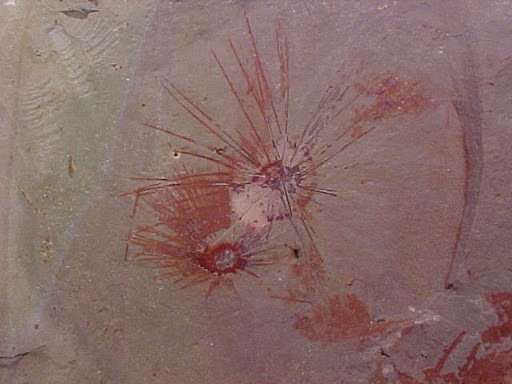
As a vertebrate paleontologist, it might seem weird that my favorite animal isn't something like Pikaia or Haikouichthys.
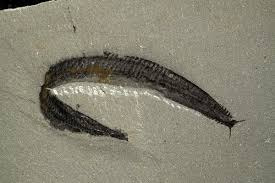
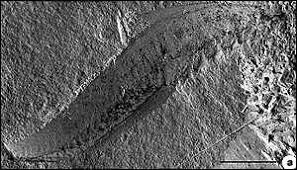
Let me explain. I was born and raised in the American southwest. Cholla (pronounced choy-uh) is a type of cactus found in southern Colorado and Utah, Arizona and New Mexico.
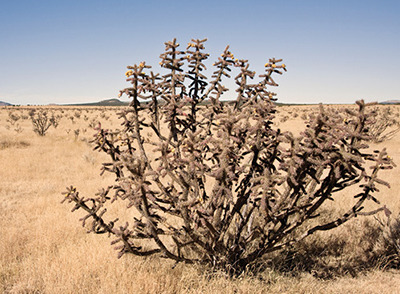
My favorite variety of cholla? Jumping Cholla. That's right. I said Jumping Cactus. This cactus uses friction to throw bits of itself at those who potentially want to steal its water and it hurts like a bitch.

There are little barbs on the ends that get lodged in the skin and you need pliers to pull them out (happened to my grandma on a date with my grandpa. Fun times for them.).
Back to the fossil Choia. It is not a cactus, nor is it even a plant. It is a type of sponge.
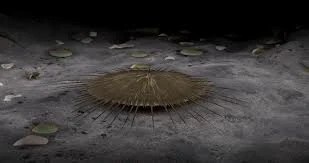
This sponge does look remarkable like a piece of cholla cactus though which is how it got its name. Now, it probably did throw its spines like the cactus but they would have made it very difficult to eat.
it is a type of demosponge, the same kind we use for bath sponges. (I don't recommend using a Choia though. There are eight species known from Canada, Utah, China and Morocco.
It was not a very big sponge at only about 2 cm in diameter though its spicules added an extra 3 cm onto that. It lived on the seafloor where spicules may have helped hold it up above the sediment-water interface.

It was a suspension feeder so particles of organic matter were extracted from the water as they passed through canals in the sponges wall.
Hope you've come to find both Choia and cholla as cool as I do. Fossilize you later!

#paleontology#fossils#paleontologist#choia#sponges#fossil friday#cambrian period#cambrian explosion#my favorite Cambrian animal
22 notes
·
View notes
Text
Archaeocyatha fossils in Wilkawillina Gorge
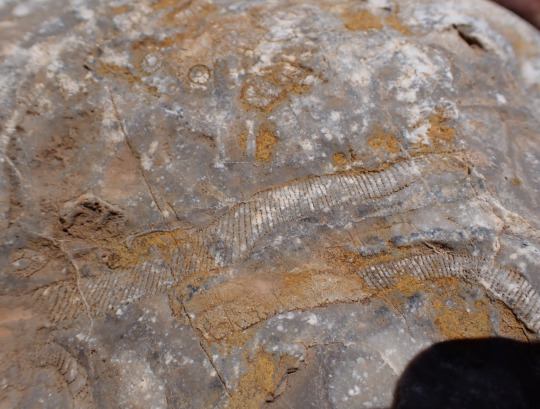

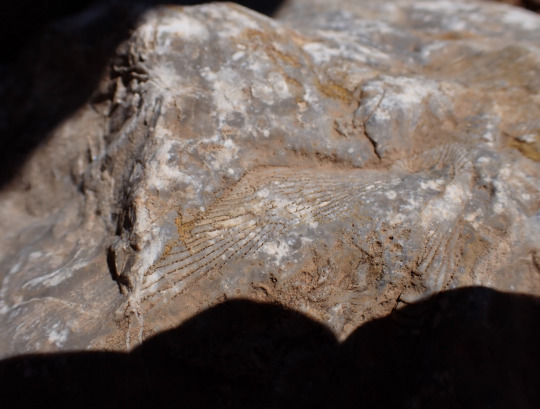
10 notes
·
View notes
Text


The new finds from the today trip to the mentioned stone road & one location with piles.
They are sponges aulaxinia sulficera - the in lengt two again and the round stone with the mold on it. I have already an specimen like this in dark flint.
Then the in half round open chert/ flint cut sponge with the inner pattern.
The first like this with an clear pattern of some struckture shown!!
And an absolutly tiny echinoid core, if you zoom in you can see the little reminicent pattern.
At first without cleaning, i was thinking it was an fungus on it, but afterwards the pattern is in the flint, likely calcite.




#fossils#geology#fossil hunt#fossil collecting#aulaxinia sulficera#sponge fossil#fossils in germany#fossils 2024#echinoid#fossil friday#fossil
16 notes
·
View notes
Text


Some fossils from our local quarry 🤩 it's one of the oldest and best preserved fossilized coral reefs in the world, I find something cool every time I go ❤️
2 notes
·
View notes
Text
Named Cyathophycus balori, the newly-identified species lived during the Carboniferous period, some 315 million years ago. It resembled the Venus Flower Basket Sponge, which is currently found in the Pacific Ocean.
When most sponges die, they usually fall apart quickly, and often only scattered remains of the spicules are preserved as fossils,
4 notes
·
View notes
Photo

Rare Fossil Sponge Porosphaera globularis – Upper Chalk Cretaceous, Kent UK – Genuine with COA
Discover a rare and fascinating piece of Earth’s ancient marine history with this authentic fossil sponge – Porosphaera globularis, dating from the Upper Chalk of the Late Cretaceous period. This unique specimen was sourced from Kent, UK, a region renowned for its rich fossil-bearing chalk formations.
Porosphaera globularis is a globular-shaped sponge species commonly found in chalk deposits and known for its distinctive porous structure. These sponges lived approximately 70–90 million years ago when much of Europe was submerged under a warm, shallow sea. Their preservation in chalk provides an incredible window into ancient marine ecosystems.
Item Details:
Species: Porosphaera globularis
Age: Upper Chalk, Late Cretaceous (~70–90 million years old)
Location Found: Kent, United Kingdom
Condition: 100% genuine fossil specimen with clear structural features
Scale: Scale cube in photo is 1cm – please refer to images for full sizing details
Photography: The specimen shown is the exact item you will receive
Packaging: Securely packaged to ensure safe delivery
This fossil is ideal for collectors, educators, or anyone with a passion for natural history. It comes with a Certificate of Authenticity, affirming its genuine origin and geological significance.
All of our fossils are carefully selected for quality and scientific interest. Don’t miss the opportunity to own a real piece of prehistoric life!
#fossil sponge#Porosphaera globularis#Cretaceous fossil#Upper Chalk fossil#Kent fossil#UK fossil sponge#ancient sponge fossil#genuine fossil#fossil with certificate#educational fossil#natural history#fossil collection#sponge fossil#chalk fossils#rare fossil specimen
0 notes
Text
The fact that sea sponges are animals makes me so happy. Sponge is animal :)
#thinking of him (stromatoporoid sponges.)#apparently you can find rhem in ohio!!! (the fossils ofc)
0 notes
Text

📷 by natureandphotography1 (Flickr, Autumn Blog, Nerdy Blog)
Please do not remove credit :)
0 notes
Text

Shishania aculeata lived during the mid-Cambrian, around 512 million years ago, in shallow tropical waters covering what is now southwestern China.
Up to about 6cm in length (~2.4"), its spine-covered body was initially thought to be an early mollusc, but the discovery of more specimens has resulted in a new interpretation: instead of a slug-like creature, the fossils of Shishania might instead represent a flattened and ruptured chancelloriid.
Chancelloriids were an enigmatic group of Cambrian animals that had hollow bag-like bodies armored with numerous sharp star-shaped spines. They were historically classified as sponges due to their similar body plan and immobile filter-feeding lifestyle, and they've also been proposed to be relatives of halkieriid molluscs due to similarities in the microscopic structure of their spines – but currently it seems most likely that chancelloriids were actually their own separate lineage of early animals, closer related to eumetazoans than to sponges.
Shishania had much simpler spines than other chancelloriids, so it may represent an early stage of the evolution of these animals' armor, showing that these structures were developed from scratch rather than adapted from a pre-existing ancestral feature.
———
NixIllustration.com | Tumblr | Patreon
References:
Durham University. "Scientists solve 500-million-year fossil mystery" Phys.org, 08 May. 2025, https://phys.org/news/2025-05-scientists-million-year-fossil-mystery.html
Wikipedia contributors. “Shishania” Wikipedia, 12 May 2025, https://en.wikipedia.org/wiki/Shishania
Yang, Jie, et al. "Shishania is a chancelloriid and not a Cambrian mollusk." Science 388.6747 (2025): 662-664. https://www.science.org/doi/10.1126/science.adv4635
Yun, Hao, et al. "Biomineralization of the Cambrian chancelloriids." Geology 49.6 (2021): 623-628. https://doi.org/10.1130/G48428.1
Zhang, Guangxu, et al. "A Cambrian spiny stem mollusk and the deep homology of lophotrochozoan scleritomes." Science 385.6708 (2024): 528-532. https://doi.org/10.1126/science.ado0059
#science illustration#paleontology#paleoart#palaeoblr#shishania#chancelloriid#invertebrate#cambrian explosion#art#not sponges or molluscs but a secret third thing
291 notes
·
View notes
Text






The haul of small fossils like an typical beachcore trip finds, but I was not near any beach or sea. I’m recently vary happy now.
All of this little fossils like the skeleton coral parts, mussels, belemnite nautiloide and crinoid traces found in my direct neighborhood & at my workplace area near the parking lot with the gravel rose beds.
I’m absolutely not near any sea. All new mussel & coral parts eagerly to find with luck within my work time outside from the last days.
After weeks of hopefully thinking, to find some coral traces myself on this area are now reality.
#fossils#fossil collecting#fossils in germany#limestone#flint fossil#brachiopode#belemnite#crinoid#sponge fossil#coral fossils#mussel fossil#fossiled snails#fossils 2024#fossil hunting#beachcore#brachiopods
5 notes
·
View notes
Text
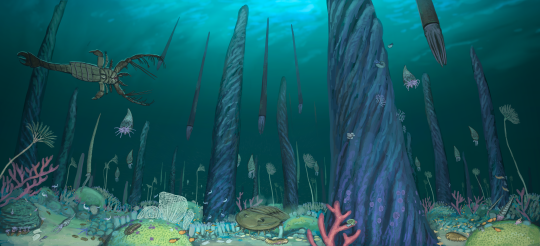
Here the result of the last formation stream of 2024. Over the course of 6 hours we explored the many organisms that inhabited the reefs of the Whitewater formation.
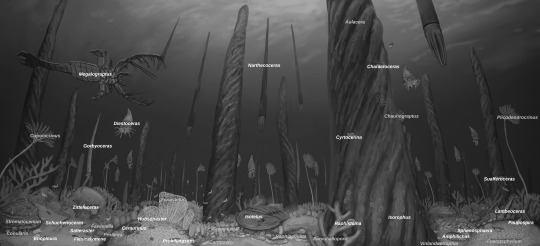
This formation preserves a rich benthic community with many sessile animals. Towering above all were the giant columnar sponges of the genus Aulacers, up to 3 m tall Ordovician skyscrapers. Between them hovered cephalopods and swam the eurypterid Megalopraptus.

Most organisms from here wer small, just a few centimeters, which is why Discord member JW made a second size chart just to bring across how the largest animals, Megalograptus and the giant trilobite Isotelus, compared to the rest.
I think something that is often overlooked in discussions about these formations is the animals we don't have. There are no crustaceans here, no jellyfish, although they probably still made up a significant part of the biomass. These animals are simply not preserved which makes our image of the Whitewater formation incomplete and biased towards the hard shelled organism. As a paleoartist one is constantly reminded of such gaps, we have to decide how much we want to speculate or borrow from other localities, or if we want to stick strictly to the fossil record.
In these formation pieces I usually do the latter but I'm painfully aware how much I miss in each piece.
Btw. since this is the last formation piece of the year I would love to hear which one was your favorite?!
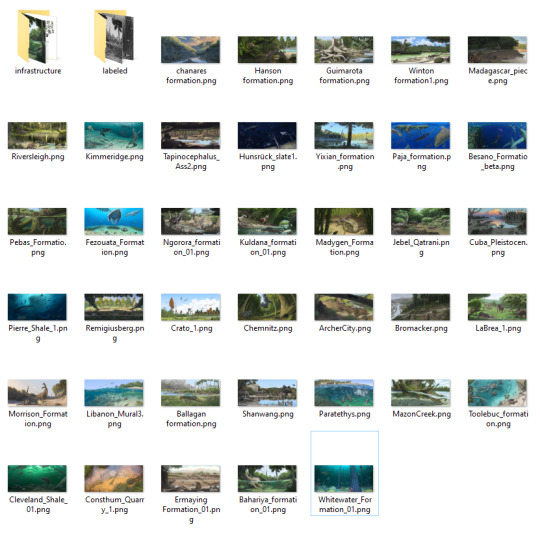
252 notes
·
View notes